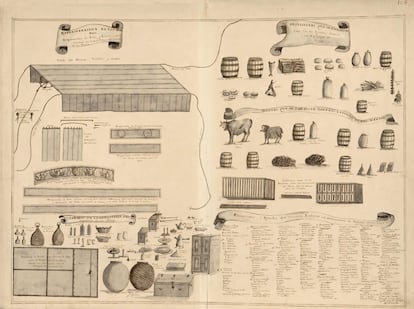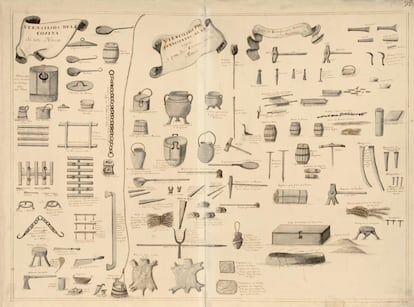Cod, pickles and lots of wine: This was the diet on an 18th century ship
In Spain, the Archive of Cádiz holds documents that reveal the dangerous job of being a cook on a ship, where eating well was a luxury reserved for the very few

Simón López, Diego Coudous and Diego Guarinelo lived between the end of the 17th century and the beginning of the 18th century, in the powerful and rich province of Cádiz, in the South of Spain. Hardly anything is known about them: neither when they were born, nor how or when their days ended. But their wills — written between 1699 and 1763 — provide two valuable pieces of information. All three were cooks on board ships that were going to make long overseas voyages… and each man felt that the enterprise they were going to embark on was so dangerous and uncertain that it was better to leave their earthly belongings behind.
The Provincial Archive of Cádiz has rescued the reflections of these three cooks from their departures and their returns. They fell seriously ill after their journey, as is made clear in the recovered documents. The archive’s initiative intends to understand the complicated — and oftentimes painful — gastronomy on board ships during those journeys, which lasted from months to years.
“Until I looked into the documentation, I didn’t realize how difficult these journeys were. It was a feat worthy of heroes,” explains researcher Antonio Ortega, one of the authors of the publication Round-Trip Cooks: Food On the Deck in the 18th Century, which was published by the Archive of Cádiz during the first week of September.
Staffing a military or merchant ship wasn’t an easy task. “There’s a lot of documentation from captains who complained about desertions when they reached land, which is why sometimes [crew members] weren’t even allowed to leave the port of call,” explains Santiago Saborido, co-author of the document and director of the Provincial Historical Archive of Cadiz, which has 8.6 miles of valuable papers on its shelves. Among all the sailors, the cook was a “necessary and important” figure, Saborido emphasizes.
So much so that Title Five of the Navy Act of 1748 equates the chef’s position at sea with that of the armorer, the lamplighter, the sailing master and the diver. “He will receive the meat and the stew, he will take care that it is washed and cooked and that nothing that could be harmful is mixed in with it. He will distribute the ration at the time that he is ordered to and, if something is missing to satisfy what was delivered, it will be supplied to those interested at the expense of the cook’s ration,” the legislative norm details.
Despite his importance, Simón López doesn’t appear in the crew register of the Nuestra Señora de los Remedios y San Francisco Javier (“Our Lady of Remedies and Saint Francis Xavier”), the merchant ship with which he signed up to head to New Spain (part of present-day Mexico) on July 19, 1699. The absence of his name is probably due to him joining the crew after the initial list was already drawn up.
What does appear is the list of provisions — preserved in the General Archive of the Indies in Seville — is what the ship’s cook had to feed 88 people over the course of 80 days of navigation. This included 17,240 pounds of ordinary sponge cake and 7,098 pounds of white sponge cake, 10,648 pounds of salted meat, 2,645 pounds of ham, 1,521 pounds of bacon, 1,216 pounds of cod, 1,318 pounds of rice, as well beans, chickpeas, raisins, almonds, sugar, oil and vinegar. That the largest load was so-called “sponge cake” wasn’t a coincidence: the double baking and the low presence of water made this bread — whose distant cousin today would actually be wheat flatbread — the ideal one to survive long months at sea. “Everything was dry, pickled, or soaked in oil. It was stored in barrels that weren’t airtight and in cellars that were very humid,” Ortega notes.

But fresh products were also shipped, such as vegetables, eggs, or live animals. This included
1,000 chickens and 80 sheep who also travelled on López’s ship. These products were the first to be consumed… but it was quite rare that they were served to ordinary sailors. “The captains, officers and people on board these voyages (which could include wealthy people or nobles) lived in a different world. Chickens were not for workers,” Ortega clarifies. For them, the Naval Act of 1748 established about 500 grams of biscuits per day, 230 grams of meat on Mondays and Thursdays (each time), 144 grams of cod on Wednesdays and Fridays, as well as 173 grams of cheese on Saturdays. Wine was worth mentioning separately: ordinary sailors could drink up to three-quarters-of-a-liter each day. “When they went far away, they weren’t given any and were compensated with money, because otherwise they would get drunk,” the researcher chuckles.
It’s not surprising that sailors took refuge in alcohol. This wasn’t only because of the hardship of physical work or overcrowded cabin life, but also, simply, because the food didn’t taste very good. Water, for example, travelled in barrels and went bad; cake went moldy from humidity, while caged chickens shared the hold with other foods. This generated a fauna of insects, weevils, or rats that — on many occasions — caused illnesses and cross-contamination. Discomfort also came from a diet that was poor in nutrients. For instance, due to the lack of vitamin C, scurvy — the most feared and deadly disease at sea — became rampant. Here again, the figure of the cook became key to avoiding food poisoning and preparing diets for the sick.
This wasn’t the only complication that López, Coudous and Guarinelo had to deal with. The cooks worked in the galley storage area, which — although it had its place on the ship — was completely removable, in case the supplies needed to be salvaged during an attack. The flames — in a wooden ship — were also very controlled, to avoid fires and to avoid being seen by the enemy at night. This meant that the food was typically eaten cold.
The Demonstrative Dictionary with the Configuration or Anatomy of all Modern Naval Architecture — written by Juan José Navarro y Búfalo, the 1st Marquess of Victoria, between 1719 and 1756 — lists the utensils that the cooks used to improvise: the cauldron (their key instrument), the oven, barrels of oil, as well as “a small bag of saffron and a box of spices” to give some color and grace to the meals.

With these resources, the cooks did what they could. Only a few recipes made at sea have survived to this day. The historian Vicente Ruiz García collected and updated a dozen of them in the book Cooking on Board, which references meals such as pea stew with cod, a kind of gazpacho with pieces of sponge cake mixed in, or vinegar-and-anchovy leftovers. Hunger took care of the rest. “There was nothing that a sailor didn’t listen to more than his own stomach,” as Vera Moya Sordo writes, in an article titled Aspects of the Naval Service and Life On Board in the Royal Fleets, which is cited in the Provincial Archive’s research.
Nothing is known about how López, Coudous and Guarinelo fared in their duties, or whether they even returned alive. Only the latter is known to have embarked on a ship — the San Martín — which, after many difficulties, took a whopping two years to reach its destination: the Province of Callao, in Peru.
What does seem clear is that the journey likely cost Sebastián Reyes, Francisco de Sotto and Antonio Mercadel their lives. All three were cooks on board 18th century ships… and all of them had to write their wills in a hurry. Upon returning to Spain, they became “seriously ill” and were admitted to the Royal Hospital of Cádiz. Again, it’s unknown when or from what they died. But their written legacies offer clues that their stories must have not ended very well. For them, the feat of being round-trip cooks was as heroic as it was fatal.
Sign up for our weekly newsletter to get more English-language news coverage from EL PAÍS USA Edition
Tu suscripción se está usando en otro dispositivo
¿Quieres añadir otro usuario a tu suscripción?
Si continúas leyendo en este dispositivo, no se podrá leer en el otro.
FlechaTu suscripción se está usando en otro dispositivo y solo puedes acceder a EL PAÍS desde un dispositivo a la vez.
Si quieres compartir tu cuenta, cambia tu suscripción a la modalidad Premium, así podrás añadir otro usuario. Cada uno accederá con su propia cuenta de email, lo que os permitirá personalizar vuestra experiencia en EL PAÍS.
¿Tienes una suscripción de empresa? Accede aquí para contratar más cuentas.
En el caso de no saber quién está usando tu cuenta, te recomendamos cambiar tu contraseña aquí.
Si decides continuar compartiendo tu cuenta, este mensaje se mostrará en tu dispositivo y en el de la otra persona que está usando tu cuenta de forma indefinida, afectando a tu experiencia de lectura. Puedes consultar aquí los términos y condiciones de la suscripción digital.
More information
Últimas noticias
Most viewed
- Sinaloa Cartel war is taking its toll on Los Chapitos
- Reinhard Genzel, Nobel laureate in physics: ‘One-minute videos will never give you the truth’
- Oona Chaplin: ‘I told James Cameron that I was living in a treehouse and starting a permaculture project with a friend’
- Why the price of coffee has skyrocketed: from Brazilian plantations to specialty coffee houses
- David King, chemist: ‘There are scientists studying how to cool the planet; nobody should stop these experiments from happening’










































